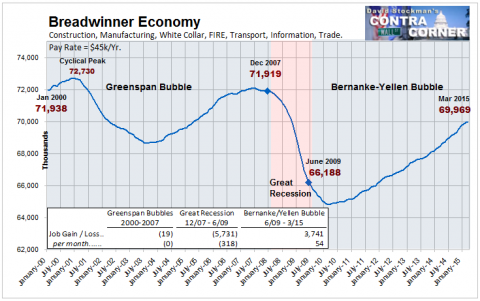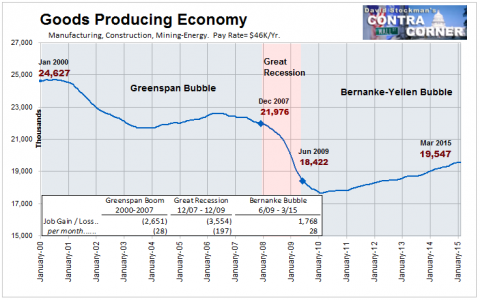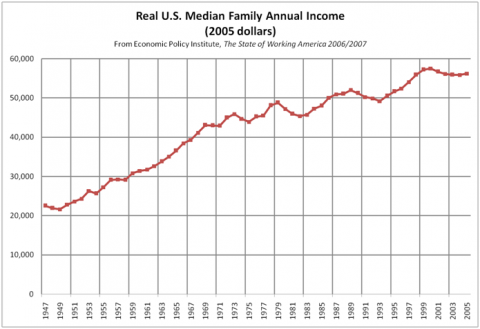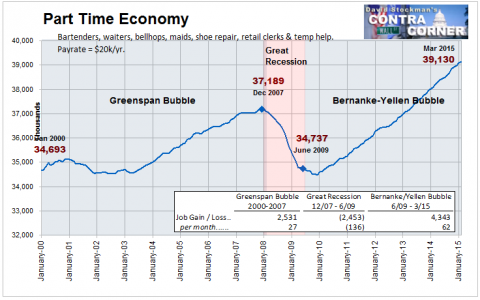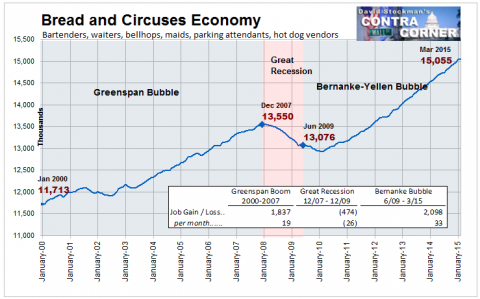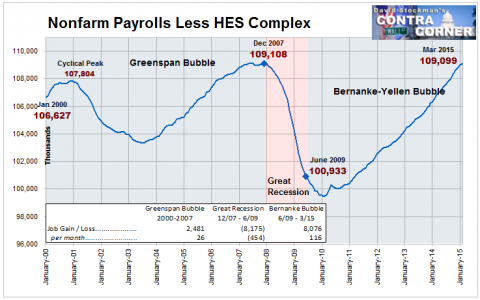On April 7, 2015, David Stockman writes on Contra Corner:
At some point 15 years ought to count for something. After all, it does amount to one-seventh of a century. And during that span we have encompassed several business cycles, two financial crises/meltdowns and nearly a non-stop blitz of “extraordinary” policy interventions. To wit, a $700 billion TARP, an $800 billion fiscal stimulus, upwards of $4.0 trillion of money printing and 165 months out of 180 months in which interests rates were being cut or held at rock bottom levels.
You’d think with all that help from Washington that American capitalism would be booming with prosperity. No it’s not. On the measures which count when it comes to sustainable growth and real wealth creation, the trends are slipping backwards—– not leaping higher.
So here’s the tally after another “Jobs Friday”. The number of breadwinner jobs in the US economy is still 2 million below where it was when Bill Clinton still had his hands on matters in the Oval Office. Since then we have had two Presidents boasting about how many millions of jobs the have created and three Fed chairman taking bows for deftly guiding the US economy toward the nirvana of “full employment”.
Say what?
When you look under the hood its actually worse. These “breadwinner jobs” are important because its the only sector of the payroll employment report where jobs generate enough annual wage income—about $50k—- to actually support a family without public assistance.
Moreover, within the 70 million breadwinner jobs category, the highest paying jobs which add the most to national productivity and growth——goods production—-have slipped backwards even more dramatically. As shown below, there were actually 21% fewer jobs in manufacturing, construction and mining/energy production reported last Friday than existed in early 2000.
Then take the matter of productivity growth. If you don’t have it, then incomes and living standard gains become a matter of brute labor hours thrown against the economy. In theory, of course, all the business cycle boosting and fine-tuning from fiscal and monetary policy, especially since the September 2008 crisis, should be lifting the actual GDP closer to its “potential” path, and thereby generating a robust rate of measured productivity growth.
Not so. Despite massive policy stimulus since the late 2007 peak, nonfinancial business productivity has grown at just 1.1% per annum. That is just half the 2.2% annual gain from 1953 until 2000. Washington engineered demand stimulus is self-evidently not pulling up productivity by its bootstraps.
Indeed, if you go back to the 1953-1973 peak-to-peak period, which also encompassed several business cycles, the annual productivity growth rate averaged 2.7% or two and one-half times the recent outcome.
But here’s the thing. That sterling outcome occurred during those allegedly benighted times under Eisenhower, who believed in balance budgets and delivered several of them. It also encompassed the “new economics” era of the Kennedy-Johnson Keynesians, who dismissed a calendar-bound balanced budget approach, but to their credit did believe in balanced budgets over the business cycle. And they made good on that theory by getting LBJ to raise taxes and cut spending when the guns and butter economy got over heated in 1968.
And most importantly, it was also the time of the “light touch” monetary policies of William McChesney Martin who presided at the Fed during most of this period. Unlike the Bernanke/Yellen Fed that can’t gets its hand off the stimulus button 70 months after the Great Recession ended, Martin once took the “bunch bowl” away only 4 months after a business recovery commenced because he believed his job was done. Growth was up to capitalism, not the FOMC.
The same picture occurs on real median household income. During the same 1953-1973 interval, real median family income grew at 3.0% annually, rising from $26k to $46k during the period.
By contrast, over the course of the next 27 years, and after Washington ended both the Bretton Woods gold standard anchor on money and the practice of balanced budgets, real median incomes grew by only 0.8% annually, rising to $57k by the year 2000.
Needless to say, its been all downhill since then. Real median income was $53k in 2014. That means median living standards of US households have been falling at a 0.5% annual rate since the turn of the century. There is no prior 15 year period that bad, including the 15 years after the 1929 crash.
The argument of the Keynesians is that capitalism is a chronic underperformer. Left to its own devices it is always leaving idle labor and capital resources on the table, and is even prone to bouts of depressionary collapse absent the counter-cyclical ministrations of the state and its central banking branch.
Yet one measure of high resource utilization most surely would be the labor force participation rate. As shown below, however, after the one-time boost of increased female participation after 1980, the trend has been in a nose-dive. And its not due to the baby-boom getting old and retiring.
The data in the graph are for the prime labor force age 16-54. Since the year 2000——a time when the Fed’s balance sheet soared by 9X from $500 billion to $4.5 trillion—–the prime age labor force participation rate has plummeted by 10 percentage points.
The exact same underutilization trend can be seen in the measures of aggregate labor hours. Even if productivity has turned punk, it might be thought that all this policy stimulus would flush labor hours into the economy. But despite an increase from 212 million to 250 million of the working age population since the year 2000, there has been virtually no gains in labor hours utilized by the private business economy.
Stated differently, the jobs Friday revilers are operating on the simple-minded assumption that all headline jobs are created equal. Yet in Q4 2014 the index of non-farm labor hours utilized by the business sector posted at 109.8——virtually the identical level recorded in early 2000.
That’s right. After growing at a 1.6% annual rate for a half-century running (1953 to 2000), labor resourced deployed have flat-lined for the past 15 years. Rather than contributing to higher utilization of resources, the massive, chronic stimulus policies of recent years have been associated with just the opposite.
The 15-year trend in the other important input to true growth and wealth creation—-real net business investment—displays the same dismal pattern. Real net investment in business fixed assets is still lower than it was in 1998.
So when it comes to the building blocks of prosperity, policy stimulus has not been stimulating much of anything—–except a slide downhill. And the reason is not hard to find.
The monetary politburo in the Eccles Building ignores all these fundamentals in order to focus on the short-run “incoming data”. It actually believes it is steering the business cycle as in times of yesteryear when the credit channel of monetary transmission still functioned effectively—even if destructively in the long-run.
But that was a one-time parlor trick. As we have consistently documented, households are at peak debt and on a net basis can no longer raise their leverage ratios to supplement wage and salary based income with more borrowings. Likewise, business borrows in response the Fed’s dirt cheap cost of debt, but the proceeds go into financial engineering, not productive investment.
So the Fed blunders forward, oblivious to the fact that it is now 2015, not 1965, maintaining the lunacy of zero or soon near-zero interest rates. That maneuver creates floods of new credits, but in the form of gambling stakes which never leave the canyons of Wall Street. So doing, they inflate financial assets values until they reach such absurd heights that they collapse of their own weight.
The Fed has thus become little more than a serial bubble machine. Tracking the incoming data during the intervals between financial boom and bust, it mistakes short run unsustainable gains for real economic growth. But overwhelmingly, this is comprised of temporary GDP and born again jobs.
That too was on display in Friday jobs report. For the second time this century we have had a boom in the part-time economy of jobs in bars, restaurants, retail, leisure and personal services. These jobs on average represent 26 hours of work per week and average wage rates of around $14/hour, thereby generating less than $20k on an annual basis.
Since the top 10% of households account for upwards of 40% of consumer spending it is not hard to see what will happen next. When this third and greatest financial bubble of this century finally collapses, the bread and circuses jobs will vanish in a heartbeat.
Then perhaps the truth will sink in. Fifteen years of policy stimulus and absolutely noting to show for it. On a net basis, the only jobs created during this entire century are in the HES Complex (health, education and social services).
The thing is these jobs have nothing to do with cheap interest rates and easy credit. They are a function of the entitlement state and the massive $200 billion per year of tax subsidies which support employer-funded health benefits.
Needless to say, if you spend enough public money in the HES Complex you will get some job growth. You will eventually get a fiscal calamity, too.


